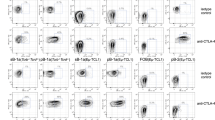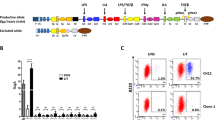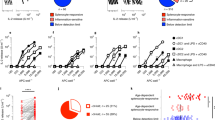Abstract
IT has long been recognized that the absence of expression of products of the major histocompatibility complex (MHC) during early development might allow the fetus to escape recognition by maternal lymphocytes. In addition to the MHC class I heavy chain and β2-microglobulin, antigenic peptide is an essential structural component of the class I molecule1–5. Indeed, there is evidence that MHC-linked genes encoding peptide transporter molecules6–10 and possibly components of a proteolytic complex11,12 are necessary for MHC class I assembly and stability at the cell surface. Here we demonstrate that embryonic cells in general show a defect in MHC class I assembly. Surface expression was rescued in the presence of an appropriate antigenic peptide, or by treatment with interferon. Consistent with this, HAM1 (ref. 9) messenger RNA was not constitutively expressed, but was inducible by interferon, and during differentiation in vitro. Thus, tolerance of the fetal allograft may in part be controlled at the level of peptide-dependent MHC class I assembly.
This is a preview of subscription content, access via your institution
Access options
Subscribe to this journal
Receive 51 print issues and online access
$199.00 per year
only $3.90 per issue
Buy this article
- Purchase on Springer Link
- Instant access to full article PDF
Prices may be subject to local taxes which are calculated during checkout
Similar content being viewed by others
References
Bjorkman, P. J. et al. Nature 329, 506–512 (1987).
Townsend, A. et al. Nature 340, 443–448 (1989).
Cerundolo, V. et al. Nature 345, 449–452 (1990).
Townsend, A. et al. Cell 62, 285–295 (1990).
Silver, M. L., Parker, K. C. & Wiley, D. C. Nature 350, 619–622 (1991).
Deverson, E. V. et al. Nature 348, 738–741 (1990).
Trowsdale, J. et al. Nature 348, 741–744 (1991).
Spies, T. et al. Nature 348, 744–747 (1991).
Monaco, J. J., Cho, S. & Attaya, M. Science 250, 1723–1726 (1990).
Spies, T. & DeMars, R. Nature 351, 323–324 (1991).
Monaco, J. J. & McDevitt, H. O. Proc. natn. Acad. Sci. U.S.A. 79, 3001–3005 (1982).
Monaco, J. J. & McDevitt, H. O. Nature 309, 797–799 (1984).
Silverman, T. et al. J. Immun. 140, 4378–4387 (1988).
Bikoff, E. K., Otten, G. R. & Robertson, E. J. Eur. J. Immun. 21, 1997–2004 (1991).
Takahashi, H. et al. Proc. natn. Acad. Sci. U.S.A. 85, 3105–3109 (1988).
Croce, C. M. et al. Proc. natn. Acad. Sci. U.S.A. 78, 5754–5758 (1981).
Morello, D. et al. Nature 296, 260–262 (1982).
Rosenthal, A., Wright, S., Cedar, H., Flavell, R. & Grosveld, F. Nature 310, 415–418 (1984).
Morello, D., Duprey, P., Israel, A. & Babinet, C. Immunogenetics 22, 441–452 (1985).
Hedley, M. L., Drake, B. L., Head, J. R., Tucker, P. W. & Forman, J. J. Immun. 142, 4046–4053 (1989).
Ozato, K., Wan, Y. J. & Orrison, B. M. Proc. natn. Acad. Sci. U.S.A. 82, 2427–2431 (1985).
Jaffe, L., Jeannotte, L., Bikoff, E. K. & Robertson, E. J. J. Immun. 145, 3474–3482 (1990).
Jaffe, L., Robertson, E. J. & Bikoff, E. K. J. Immun. (in the press).
Margulies, D. H. et al. J. Immun. 130, 463–470 (1983).
Bernstine, E. G., Hooper, M. L., Grandchamp, S. & Ephrussi, B. Proc. natn. Acad. Sci. U.S.A. 70, 3899–3903 (1973).
Robertson, E., Bradley, A., Kuehn, M. & Evans, M. Nature 323, 445–448 (1986).
Gunning, P., Leavitt, J., Muscat, G., Ng, S. Y. & Kedes, L. Proc. natn. Acad. Sci. U.S.A. 84, 4831–4835 (1987).
Ljunggren, H. G. et al. Nature 346, 476–480 (1990).
Robertson, E. J. in Teratocarcinomas and Embryonic Stem Cells: A Practical Approach (ed. Robertson, E. J.) 71–112 (IRL, Oxford, 1987).
Rudnicki, M. A. & McBurney, M. W. in Teratocarcinomas and Embryonic Stem Cells: A Practical Approach (ed. Robertson, E. J.) 19–49 (IRL, Oxford, 1987).
Author information
Authors and Affiliations
Rights and permissions
About this article
Cite this article
Bikoff, E., Jaffe, L., Ribaudo, R. et al. MHC class I surface expression in embryo-derived cell lines inducible with peptide or interferon. Nature 354, 235–238 (1991). https://doi.org/10.1038/354235a0
Received:
Accepted:
Issue Date:
DOI: https://doi.org/10.1038/354235a0
This article is cited by
-
Immunological Barriers to Stem-Cell Based Cardiac Repair
Stem Cell Reviews and Reports (2011)
-
Molecular mechanisms of class I major histocompatibility complex antigen processing and presentation
Immunologic Research (1996)
-
Recombinant expression of vaccinia virus‐encoded TAP1 and TAP2 promotes MHC class I‐restricted antigen presentation in a Syrian hamster cell line
Immunology & Cell Biology (1995)
-
MHC class I genes are not imprinted in the mouse placenta
Immunogenetics (1994)
Comments
By submitting a comment you agree to abide by our Terms and Community Guidelines. If you find something abusive or that does not comply with our terms or guidelines please flag it as inappropriate.



